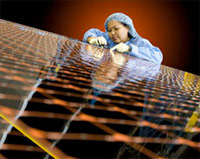Today's most advanced and commercially available solar cells convert sunlight from the visible spectrum, but now thanks to a new material being developed in Spain researchers think they have a way to convert light from the infrared part of the solar spectrum, which amounts to about half the Sun's power into usable energy. 
Conventional solar cells are based on a semiconductor such as silicon. But their inability to soak up infrared gives them a theoretical absorption limit of just over 40% of solar energy. In practice, they only absorb about 30%.
The new material, though, can harness both visible and infrared photons, so it has a theoretical maximum efficiency of 63%, it creators say, and should give significantly better real-world performance.
Semiconductor solar cells produce electricity when photons carrying just the right energy are absorbed by trapped electrons, boosting them into a higher energy level where they can flow freely.
Cells can't make electricity from photons with much more or less energy than the right amount. Cells are tuned to visible light because visible photons vary little in energy, but reach earth in very large numbers. But in 1997 other Spanish researchers came up with a way to increase the spectrum cells could use.
Their idea was to create a kind of energy "stepping stone". Instead of having to jump to the higher energy level in one go, electrons can absorb a low-energy photon and then wait at an intermediate energy level until another arrives to let it complete the trip.
Now researchers led by Perla Wahnón at the Institute for Solar Energy at the Polytechnic University, and José Conesa at the Institute of Catalysis of the Spanish Higher Scientific Research Council, both in Madrid, used that idea to design their new solar-cell material.
They add titanium and vanadium atoms into a conventional semiconductor, altering its electronic properties to create the intermediate energy level. The Spanish team calculates that its material can theoretically capture 63% of the Sun's rays.
The real-world efficiency of cells based on the new design wouldn't reach 63%, explains Conesa. "But if the [theoretical] limit is higher, you can presume that the real figure that you will be able to reach will also be higher." Early versions of the material match the properties predicted and, although a solar cell hasn't yet been made, the team aims to in the near future.

